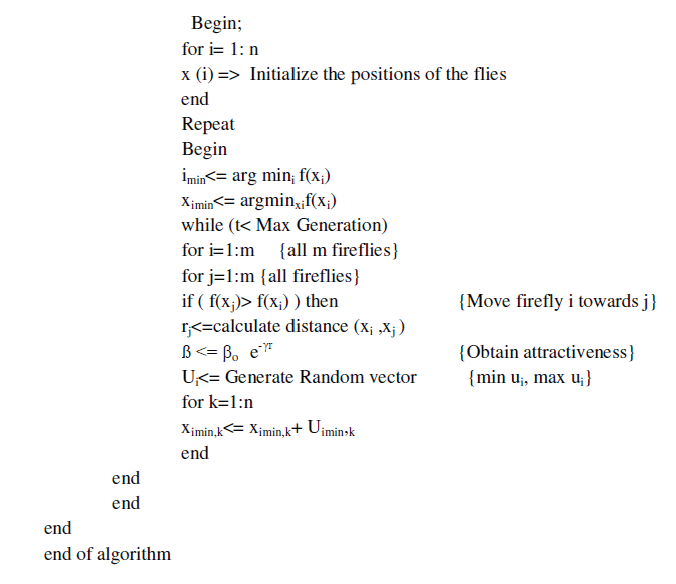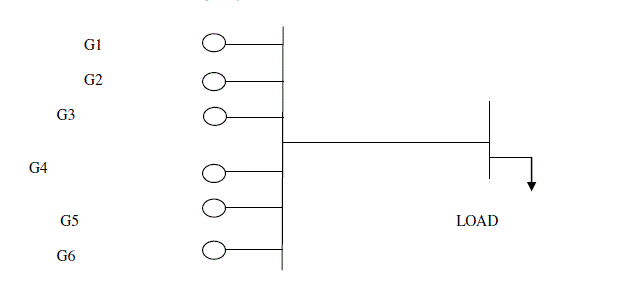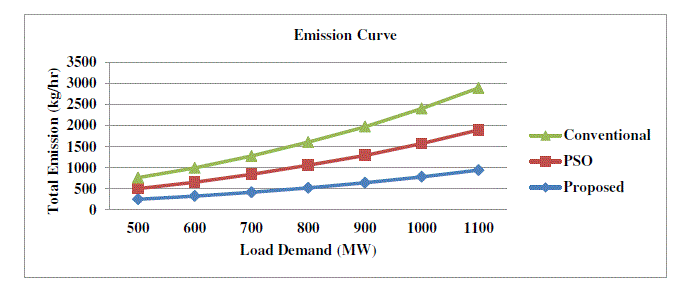Keywords
|
| Emission dispatch, Firefly Algorithm, Test System, Simulation and Performance analysis. |
INTRODUCTION
|
| Scheduling of power plant generation is gives a great importance in electric power utility systems. One of the prime concerns from social and environment aspects is that both human and non-human life forms are severely affected by the atmospheric pollution caused during generation of electricity from fossil fuels. The fossil fuel releases several contaminants such as sulphur oxides (SOx), nitrogen oxides (NOx) and carbon dioxide (CO2) into the atmosphere. This may give rise to the problem of global warming [1]. Recently the problem has attracted much attention is pollution minimization due to increasing concern over the environmental consideration [2], society demands adequate and secure electricity not only at the cheapest possible price, but also at minimum level of pollution. So the optimal scheduling of generation in a thermal power plant system involves the allocation of generation so as to optimize the fuel cost and emission level simultaneously.Several strategies to reduce the atmospheric emissions have been proposed and discussed [3-5]. These include installation of pollutant cleaning equipment, switching to low emission fuels, replacement of the aged fuel-burners with cleaner ones, and emission dispatching. Different optimization techniques like particle swarm optimization (PSO), Genetic algorithm (GA), simulated annealing (SA), Artificial Bee Colony (ABC) have been reported [6-10] in the literature pertaining to environmental / economic dispatch (EED) problem. |
| This paper proposes the Firefly optimization Algorithm to reduce the carbon dioxide emission from thermal power stations. The implementation of the above algorithm is organized as follows. The mathematical formulation of emission dispatch problem is discussed in section II. The proposed firefly algorithm and their characteristics are analysed in section III. The implementation of above algorithm is presented in section IV. In section V gives a description of test system. In section VI includes the simulation results with discussion and conclusions in section VII. |
PROBLEM FORMULATION
|
| The objective of solving emission dispatch problem is to minimize the emission level of the electric power system, while satisfying a set of constraints. This can be formulated as follows: |
A. Problem objective
|
| Minimization of emission: The objective function for the total (kg/hr) emission can be expressed as |
 (1) (1) |
| The emission equation of a generating unit is usually described by a quadratic function of power output Pi as follows: |
 (2) (2) |
| where, Ei (Pi) is the emission (Kg/hr), Pi is the power generated (MW) and di, ei, fi is the emission coefficients of the i th unit. |
B. Problem constraints
|
| Generation capacity constraint: For stable operation, real power output of each generator is restricted by lower and upper limits as follows |
 (3) (3) |
| Power balance constraint: The total power generation must cover the total demand PD and the real power loss in transmission lines PL. Hence, |
 (4) (4) |
C. Problem Statement
|
| Aggregating the objective and constraints, the problem can be mathematically formulated as a nonlinear emission constrained single objective optimization problem as follows |
 (5) & (6) (5) & (6) |
| where, g is the equality constraint representing the power balance and h is the inequality constraint representing the unit generation capacity. |
PROPOSED APPROACH
|
| Recently the proposed Firefly algorithm can be effectively used to eliminate the carbon dioxide emission in thermal power plants. The Firefly optimization algorithm is based on the biochemical and social behavior of the fireflies. |
A. Firefly Algorithm
|
| The Firefly algorithm (FA) is a meta-heuristic algorithm, inspired by the flashing behavior of fireflies or lighting bugs. The primary purpose for a firefly’s flash is to act as a signal system to communicate with other fireflies, especially to prey attractions. |
| This firefly algorithm by assuming: [11] |
| 1) All fireflies are unisexual, so that one firefly will be attracted to other fireflies. |
| 2) Attractiveness of each firefly is proportional to its brightness, thus for any two flashing fireflies, the less bright firefly will move towards the brighter one. The attractiveness is proportional to the brightness and they both decrease as their distance increases. If there is no brighter one than a particular firefly, it will move randomly. |
| 3) The brightness of a firefly is determined according to the nature of the objective function. |
(i) Attractiveness
|
| The attractiveness of a firefly is determined by its brightness or light intensity which is obtained from the objective function of the optimization problem. The attractiveness β can be defined by [1β]: |
 (7) (7) |
| Where r is the distance of two fireflies, βo is the attractiveness at r = 0, and γ is the light absorption coefficient. |
(ii) Distance and Movement
|
| The distance between any two fireflies i and j at positions xi and xj, respectively, can be defined as a Cartesian or Euclidean distance as follows [13]: |
 (8) (8) |
| Where xi,k is the kth component of the spatial coordinate xi of the ith firefly and d is the number of dimensions. |
| The movement of a firefly i towards a more attractive (brighter) firefly j is determined by the following equation: |
 (9) (9) |
| where the first term is the current position of a firefly, the second term is related to the attraction and the third term is randomization with the vector of random variables εi using a normal distribution. |
IMPLEMENTATION OF THE PROPOSED ALGORITHM
|
| In this algorithm all the fireflies initially will be the random locations in the search space. The pseudo code for the Firefly optimization algorithm is as follows: |
 |
 |
TEST SYSTEM
|
| The emission dispatch problem based on firefly optimization algorithm has applied to the six generator test systems at different load conditions. Multiple generator limits and total emission level of the system is simulated in order to evaluate the correctness and quality of the method. |
| The emission constants and the generator limits of a 6 generator system are tabulated below. |
SIMULATION RESULTS AND DISCUSSIONS
|
| The proposed approach was tested on the six generator system for various load demands. Table.2 Show that the comparisons of the performance of the firefly algorithm with the particle swarm optimization Technique. |
| The individual powers to the six generators for various demands are tabulated below. |
| Fig.2 show that the comparison graphs for emission of carbon dioxide for six generator test system. The graphs contain the emission (kg/hr) on the Y axis and Load demand (MW) on the X axis. |
CONCLUSIONS
|
| The Firefly Algorithm has been applied for optimizing the economic dispatch problem for minimizing the emission level of the thermal power plants. It is seen from the simulation results that the proposed method reduces the global warming by minimizing the concentration of co2 in fossil burning of fuels. The numerical solution is analytic in nature with high accuracy involving less computational time. Simulations and results indicate that the proposed firefly algorithm is superior to existing meta-heuristic algorithms. |
Tables at a glance
|
|
|
Figures at a glance
|
 |
 |
| Figure 1 |
Figure 2 |
|
References
|
- M.Basu,”Economic environmental dispatch of hydrothermal power system”, Electric power and Energy syst. γβ (β010) 711-720.
- IEEE working group, “Potential impacts of clean air regulations on system operations”, IEEE Transaction on power systems, vol.10.pp.647-653,1995.
- El-keib AA, Ma H, Hart JL,” Economic dispatch in view of the clean air act of 1990”, IEEE Transaction on power systems, 1994;9 (2):972-978.
- Talaq JH, El-Hawary F, El-Hawary ME,” A summary of environmental/economic dispatch algorithms”, IEEE Transaction on power systems1994;9 (3): 1508-1516.
- Helsin JS, Hobbs BF,” A multi-objective production costing model for analyzing emission dispatching and fuel switching”, IEEE Transaction onpower systems.1989;4(3):836-842.
- M.A.Abido,” A niched pareto genetic algorithm for multi-objective environmental / economic dispatch”, Electric power and energy systems.25(2003) 97-105.
- K.P.Wong and C.C.Fung,”Simulated annealing based economic dispatch algorithm”, procInstElect.Eng.Gen.Trans. Dist. Vol.140, no.6 pp.505-519, Nov 1993.
- D.C.Watter and G.B.Sheble,”Genetic algorithm solution of economic dispatch with valve point loading”, IEEE Transaction on powersystems.vol.8, no.3, pp.1325-1332, Aug 1993.
- Gaurav Prasad Dixit,” Economic Load dispatch using Artifial Bee Colony optimization”, International Journal of Advances in ElectronicsEngineering.
- M.A.Abido,” Multi-objective particle swarm optimization for environmental economic dispatch problem”, Elect power systems Research vol.79,no.7, pp.1105-1113, July 2009.
- X.S.Yang,” Nature-Inspired meta-heuristic Algorithms”, Luniver press, Beckington, UK, 2008.
- X.S.Yang,” Firefly algorithms for multimodal optimization”, proceedings of the Stochastic Algorithms: Foundations and Applications(SAGA’09) vol.579β of Lecture Notes on computing sciences, pp. 178, Springer, Sapporo, Japan, October β009.
- X.S.Yang,” Firefly algorithm, stochastic test functions and design optimization”, International Journal of Bio-Inspired computation, vol.2,no.2.pp.78-84, 2010.
- Research article,” Application of the firefly algorithm for solving the economic emissions Load dispatch problem”, International Journal ofcombinatorics vol.23 pages, 2011.
- K.Senthil, K.Manikandan, Ignatius A Herman, L.Saravanan,” Reduction of carbon dioxide Emission in Thermal power plants by using Particleswarm optimization Technique”, International Journal of computer Applications, vol.γ, June β010.
|